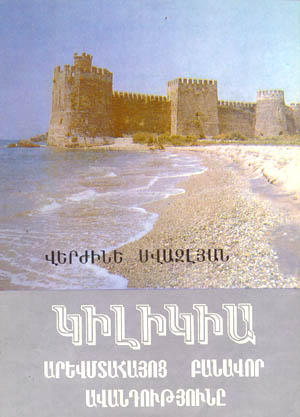
| About this page in Armenian |

The medieval Armenian State Cilicia was situated on the South East of Minor Asia and North East Coast of the Mediterranean Sea.
During three centuries of its glorious sovereign state (XI-XIV centuries) the Armenian Cilicia was famous for its developed political, economic system. Here flourished the trades, educational centres of science and culture.
After the Genocide of the Armenians in 1915, the deportation from Cilicia (1921) and the disaster of Ismir (1922), considerable part of the Western Armenians was exterminated. The rest, who escaped and survived by miracle, remained homeless and unmotherland. So they were obliged to settle in different countries of the world, creating the Armenian Diaspora as a historical phenomenon.
After long wanderings, most of them repatriated to Soviet Armenia and settled in new localities, which symbolized their past cradle.
From the representatives of the eldest generation which suffered, eye-witnesses of the historical events we mentioned above, by our own initiative, since 1950s, we inscribed numerous memories, historical folk tales about historical events and features, as well as songs and epical songs of various genres, which in artistic forms reproduced the past flourished life, customs and mode of life of the Cilician Armenians, who suffered because of the forced massacre and deportation organized by the Turks, the honest and fair struggle, which the Cilician Armenians held against that violence from the beginning of the insurrection of Zeytoun 1862 until the heroic resistance of Moussa Dagh, Yedessia (1915), and also Adana, Aintab, Hadjn and other places in 1920, until the forced deportation of the Cilician Armenians and Anatolia, their wanderings and repatriation, their adaptation to the new mode of life of their Homeland, including the actual events of nowadays and the confirmation of the new Sovereign Armenian State.
That period is saturated with rapid social-historical events, and this collection includes memorized folklore materials of this period, which until now by different causes was not inscribed and studied.

While inscribing the materials of the collection we tried to maintain the irreproachable oral speech of the narrator. The dialect materials are presented as it is accepted in the scientific transcription, having in particular the dialect of Cilicia (Zeytoun, Hadjn, Marash, Moussa-Dagh, Kessab, Beylan, Deurtyol, Sis, Tarsone, Adana, Mersine) and also the oral folklore of other Western Armenian regions (Yedessia, Tikranakert, Bitlis, Erzroum, Van, Harput, Keghy, Balou, Malatya, Kesarya, Sebastya, Shabin-Karahisar, Adabazar, Eskishehir, Boursa, Biledjik, Nicomidie, Rodosto, Tchanakgale, Smyrne, Constantinople) in Armenian and Turkish languages accompanied by our literary Armenian translations.
The materials of the collection are mainly inscribed in Armenia, partial in the USA and Greece and are grouped and systematized in four parts.
The collection has a vocabulary of foreign words and dialects, footnotes, a map, songs accompanied by musical notes, historical-ethnographical photos.
The introduction of the collection includes information about the historical past of the Cilician Armenians, their political, economic, spiritual and cultural life.
In applying the least scientific modern methods of quantitative analyze in folklore science, we studied the sex-age relation of 230 narrators, comparing with their 1461 unit information in various genres materials.
The folklore materials and memories of this of this folk-historical collection, for its originality and historical value, shall be the witness for the objective illumination of the Armenian Genocide and other historical events by a simple, popular language, and so they appears as historical reliable documents.

|
Previous Moussa Dagh | Next Genocide |